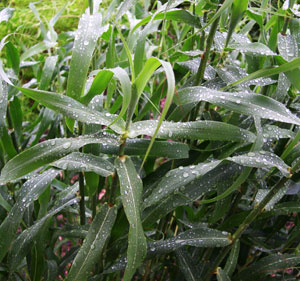| |
Palmarosa (Cymbopogon martini)
 |
Palmarosa oil is extracted from Cymbopogon martini (also known as Cymbopogon martinii var. martinii) of the Gramineae family and is also known as East Indian and Turkish geranium, as well as Indian rosha and motia.
This particular essential oil is fast becoming a firm favorite in essential oil therapy and aromatherapy, as it has excellent skin care properties and is also used to relieve stiff and sore muscles, while calming the mind and uplifting and invigorating the spirits and clearing muddled thinking.
Oil properties
Palmarosa oil has a sweet floral, with a hint of rose smell and is pale yellow in color with a nearly watery viscosity.
Origin of palmarosa oil
It is a wild growing, herbaceous green and straw-colored grass, with long slender stems, terminal flowering tops and fragrant grassy leaves. It is harvested before the flowers appear and the highest yield is obtained when the grass is fully dried - about one week after it has been cut.
There are two varieties of grass from which the oil can be extracted - motia and sofia. We find the sofia chemotype to be far more active and pleasant smelling - and for this reason the oil sold by us is from this chemotype.
Because palmarosa oil has a rose-like smell, it is often used by unscrupulous essential oil wholesalers and retailers to adulterate rose essential oil.
It is often used as an ingredient of soaps, perfumes and cosmetics, and is also used in the flavoring of tobacco.
Extraction
Palmarosa oil is extracted from the dried grass harvested before it flowers by steam distillation. The yield is 1 - 1.5 %.
Chemical composition
The main chemical components of palmarosa oil are myrcene, linalool, geraniol, geranyl acetate, dipentene and limonene.
Precautions
Palmarosa oil has no known contra indications and is considered a non-toxic, non-irritant and non-sensitizing essential oil.
Therapeutic properties
The therapeutic properties of Palmarosa oil are antiseptic, antiviral, bactericide, cytophylactic, digestive, febrifuge and hydrating.
Uses
Palmarosa oil calms the mind, yet has an uplifting effect, while clearing muddled thinking. It is used to counter physical and nervous exhaustion, stress-related problems and nervousness.
It is most useful during convalescence and cools the body of fever, while aiding the digestive system, helping to clear intestinal infection, digestive atonia and anorexia nervosa. It is effective in relieving sore, stiff muscles.
Palmarosa oil moisturizes the skin, while balancing the hydration levels and stimulating cell regeneration. It balances production of sebum, to keep the skin supple and elastic and is valuable for use with acne, dermatitis, preventing scarring, rejuvenating and regenerating the skin, as well as fighting minor skin infections, sore tired feet and athlete's foot.
Summary
Palmarosa oil could be used with good effect on the skin, for nervous and stress-related problems and for the digestive system.
Burners and vaporizers
In vapor therapy, palmarosa oil can help during convalescence. It relieves fatigue, nervousness, exhaustion and stress, while having an uplifting effect on the mind and clearing muddled thoughts.
Blended massage oil or in the bath
In a blended massage oil or diluted in the bath, palmarosa oil can be used on convalescent patients, to fight exhaustion, fatigue, nervousness, stress, bolstering the digestive system, while boosting the health of the skin.
Wash, lotions and creams and used neat
Palmarosa oil can help clear up infections and prevent scarring when added to the water used to wash the wound. When included in creams and lotions, it has a moisturizing and hydrating effect on the skin, which is great to fight wrinkles. It also balances the natural secretion of sebum, which keeps the skin supple and elastic.
On cellular level, it helps with the formation of new tissue and for that reason is great for rejuvenating and regenerating the skin. It is most useful when fighting a dry skin and to sort out skin infections. Some people find that they have great results when applying palmarosa oil neat to the affected area of athlete's foot - but please keep in mind that we do not advocate the use of neat essential oils on the skin.
Although essential oils blend well with one another, Palmarosa oil blends particularly well with geranium, bergamot, rosemary, lime and ylang-ylang.
Disclaimer: The information presented herein is intended for educational purposes only. These statements have not been evaluated by the FDA and are not intended to diagnose, cure, treat or prevent disease. Individual results may vary, and before using any supplements, it is always advisable to consult with your own health care provider.
|
|


















